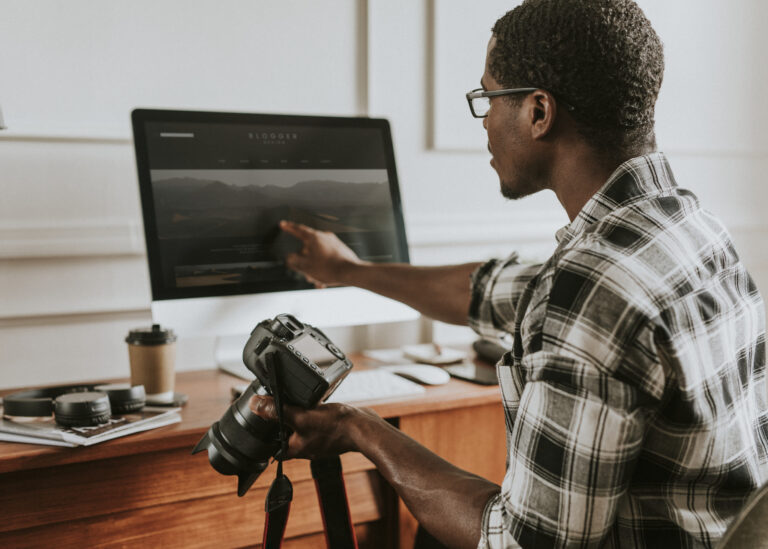
Community over competition. It’s something we often say in this Rising Tide community but what does it look like? Is it sharing a friend’s Instagram post to stories? Scheduling a coffee chat with a new friend? Purchasing one of their digital templates? Yes, exactly!
Community over competition looks like not being afraid to highlight someone else because you think it will stop you from growing.
What community over competition looks like is mutually beneficial, impactful collaborations. Finding new biz besties helps you grow your visibility and income, things we need to do as business owners anyway. Collaborations help find your footing as an entrepreneur and pivot towards purpose.
Here are 8 ways to more impactful collaborations:
1. Decide on a Collaboration Style that Works for You
I’ve used a few types of collaborations over five years in business including developing a video content series, guest blog posts, round-up blog posts and guides, building directories, participating and hosting summits. Your collaboration type has to be specific to what you want to accomplish.
- A guest blog swap should have high activity at the beginning but if leveraged correctly (ahem keywords, word count, long term relevance) then it has the potential to continuously grow your traffic via SEO.
- Participating in a summit should boost your email list or visibility in the short term and send new potential clients and customers your way.
- If you’re considering hosting a summit know that you’re going to work for every bit of payoff but in my experience, it has the most potential to quickly gather a community and increase visibility.
- A directory takes a lot of planning, a lot of implementation, but it’s a gift that keeps giving to yourself and your audience. I can’t tell you how many people have said “I hired so and so from your directory or booked a speaker from The Hill Creatives!” It always adds a little pep to my step that day.
2. Effectively Use Your Time
An easy rule of thumb; the more people involved the more work you’ll end up doing which means you need to effectively use the time that you do have to execute a top-notch collaboration. Whether you decide to go the guest blog route or an income-producing summit the steps you’ll go through to get the most out of the collaboration are generally the same.
3. Set Realistic Time Commitment Expectations
Always double the amount of time you plan on spending on your collab. You’ll be surprised at the amount of time you’ll spend outlining, emailing collaborators back and forth, fixing broken tech, updating sales pages, embedding Flodesk forms, scheduling social posts, writing sales emails, etc.
Always give yourself more buffer than you anticipate needing. I’ve set aside two to three months for every successful summit I’ve worked on but always wish I gave myself five to six months to execute.
When setting your time expectations, make sure you’re not overburdening your collaborators with requirements to send multiple emails, schedule social posts and pre-record long presentations on short deadlines.
4. Map Out Everything before Reaching Out to Collaborators
One thing that helps you determine how long your collaboration will take is to map out all of the tasks you’ll need to complete. Start high-level with overarching tasks such as:
- Reach out to and confirm collaborators,
- Build website/sales page,
- Plan marketing strategy,
- Setup tech tools, etc.
Pro Tip: From there, go back and add in more details. When you see everything you need to do in front of you, estimate the time you’ll need for each of these things and schedule them on a calendar. Keep in mind that you’re still running a business and a lot of these tasks are dependent on people outside of your business responding to you. This is why I suggest two to three times the amount of time you plan to spend on a collaboration.
5. Create a Wishlist of Collaborators
You probably dreamed up your collaboration with a few people in mind already! Make sure to put those down on (digital) paper. This makes it easier to see any potential holes in topics, demographics or any overrepresentations of topics or demographics. If you find issues with your potential line-ups, you need to spend a little more time diving through your digital Rolodex to find people to potentially work with.
6. Vet your Idea & Consider Objections
Before you talk to potential collaborators, always vet your idea with trusted biz friends and experts in the field. Most of my larger collaborations have started with a DM to a friend asking, “Is this crazy?” before doing large amounts of leg work. It’s saved my butt so many times!
7. Consider Objections
Once you start reaching out to collaborators it’s going to get hectic so it’s important to have as much as humanly possible planned out before contacting them. Some of these details are going to be the difference between a yes and a no so the more work you do define these the smoother it will go. Before talking to potential collaborators answer these questions:
- When is the event?
- When is the promotional period?
- What time commitment is expected from collaborators?
- What platforms you’ll use (ie Zoom, Hopin, Crowdcast, Facebook groups, etc.)?
- What accessibility measures will you take?
- Who all is involved?
- How will you communicate moving forward?
- Will there be a community?
When I planned to host The Hill Roundtables, I knew there were going to be objections because DEI (diversity, equality and inclusion) is a topic a lot of people have a lot of opinions on. Before reaching out to speakers we decided what our deal breakers were and how we were going to protect our community in our space. Our lines were crossed multiple times but because we had done the work beforehand we were able to respond to most objections seamlessly.
8. Consider Having a Collaboration Partner or Outsourcing
Work on a summit, consider a partner to take some of the stress of doing everything off of you and have someone just as invested as you are in the event of succeeding!
For me collaborating with someone else on collaboration makes it feel more like a community activity for me and takes the stress out of the icky parts of executing. If you’re a procrastination warrior like I am, then this also helps you stay on top of deadlines.
Pro-Tip: If you can manage to hire a VA or admin to handle communication with collaborators, do research and manage your community you’ll free up yourself for more high-level tasks. I strongly recommend it and though I might consider a summit without a collaborator, I won’t ever consider doing one without admin help.
If you’ve gotten to the reach out to collaborators stage you’ve done a lot of the hard work already. While it may be a little frightening to hit send on that email, there’s a way to give yourself extra bits of joy as you do this and build yourself up along the way.
Create a Reachout Template
Include all the necessary details to send to potential collaborators but personalize each one. My template always includes important details like the event topic, why it’s happening, when it’s happening, compensation, time commitment and next steps. I personalize each asks with why I’m specifically reaching out to them and how I’d like them to participate.
This means sending anywhere from 30-40 individual emails, replying to every individual up to one to three times before confirming and a half dozen or so communications between confirmation and the actual collaboration.
Pro-Tip: Create an information page with all of the important details even more spelled out that potential collaborators can refer to. When sending individual reach-out emails, alternate subject lines to lessen the chance of ending up in the promotions, updates, spam tab.
Reach out to Easy Yeses First
An easy yes comes from people like your close business (and real-life) friends who support you no matter what. It’s also the people who helped vet your collab and people you collaborated with in the past. Those first yeses make you feel excited about the event, especially if you’ve already been bogged down in details like building speaker pages, hiring a VA and finalizing contracts.
How to Handle a No
Unfortunately, people are going to say no. Some will say no because of schedule, a topic that doesn’t fit with the direction of their brand, the time commitment, or compensation. These are expected and why you create a large list of potential collaborators. Be okay with these and move on.
If you receive feedback consider it but don’t feel the need to reinvent your already vetted summit. People are allowed to not want to participate because they don’t feel called or comfortable but they aren’t allowed to usurp your event. If they want to speak on a topic that’s not aligned with your collaboration, they are fully in their power to go put on their event. Don’t let them wreck your energy because it could carry over to your collab and end up hurting your other collaborators and audience. Protect your safe space.
Focus on the Follow-Up
It might seem like I skipped over the actual collaboration part but if you handle the before and after right, your collaboration is going to run smoothly and become an easily predictable and repeatable part of your business.
- Schedule time to get feedback on your event after it’s completed.
- Collect reviews from your DMs, email, community and any other place they might live.
- I’d also consider a higher-touch activity like sending out a survey or scheduling a virtual meetup after a large event. If you’re hosting a challenge, schedule a networking session.
Pro Tip: After my last summit, I hosted a Happy Hour for highly engaged participants. It was great to connect on that level but also to get usable feedback, reviews and garner interest for another summit.
Don’t forget to follow up with your collaborators!
Make sure to send a thank you and also consider a small token of appreciation. If you are considering hosting another similar collaboration, they are going to help you seal the deal on new collaborators so getting feedback from them is a really important follow-up step.
Schedule Self-Care Time After!
After your collaboration, follow up with yourself. Don’t expect to hop right back into biz and life as normal after a large event. You’re going to be emotionally spent so schedule some time off and take a day or off to recharge. It will give you time to reflect, consider your next steps, or just do nothing. You deserve it because you’ve been grinding for a while.
I always say if you’re going to do it, do it well. More impactful collaborations are going to take more effort to plan, more effort to execute, but will have a higher payoff in the end. Collaborations have a lot of potentials to increase your visibility and anytime you do that you’re going to increase your network and revenue.
There are many ways to increase your visibility such as hosting a podcast, using paid ads, or showing up on social every day. While they will make you more visible they don’t always have the added benefit of designating your business as a place where community over competition survives and thrives.
Learn more about how I integrate the community in my business, get a behind-the-scenes look at the Speakeasy, my intentional marketing community for marketers, CEOs and freelancers!
HoneyBook, the best crm for solopreneurs, streamlines everything you need to manage your business into one place. Manage projects, book clients, send an online invoice and get paid through our online payment software. Now peace of mind comes with just one login.



